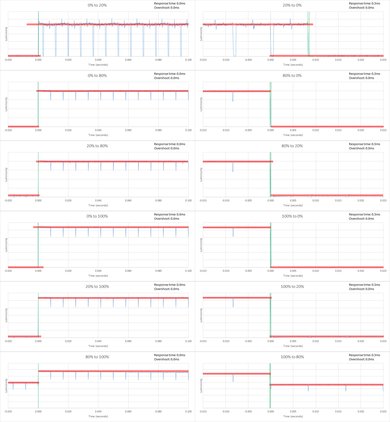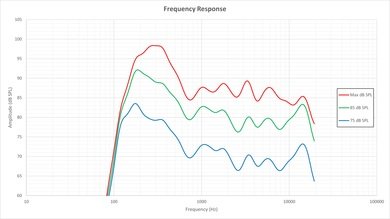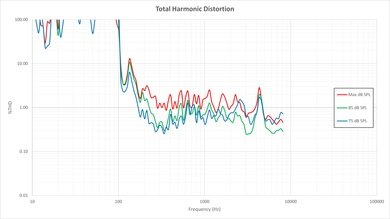The LG OLED EG9100 TV has really excellent picture quality and has even improved compared to the last generation OLED EC9300. However, it still shares the same big flaws, poor uniformity with dark colors, and the screen's brightness varying, depending on the scene.
Our Verdict
Great for mixed usage. Excellent picture quality for watching movies or TV and handles motion very well. Unfortunately it can't get very bright.
-
Great viewing angle
-
Perfect blacks
-
Perfect motion (but flicker free)
-
Varying luminosity depending on the scene (ABL)
-
Purple reflections in a very bright room
-
Poor uniformity in the dark shadows
-
Prone to temporary image retention after displaying static images
Movie performance is very good. Dark appear rich with perfect blacks and contrast. Excellent picture quality.
Great for watching TV. Picture quality remains great when watched from anywhere in the room. Deals well with reflections but unfortunately can't get very bright to stand out in a bright room.
Great sports performance. Almost perfect response for great motion handling. Great picture quality. Unfortunately the screen dims when viewing large bright scenes such as hockey.
Great for video gamers. For fast paced games there is almost no motion blur. Input lag is average but should not be an issue for most people.
Average HDR performance. Supports a wide color gamut but can't get very bright. Picture quality is great.
Good PC monitor. Limited to 120Hz but has very good picture quality and average input lag. Almost no motion blur. Supports chroma 4:4:4 for sharp text.
- 7.9 Mixed Usage
- 8.2 Movies
- 8.0 TV Shows
- 8.1 Sports
- 7.7 Video Games
- 6.0 HDR Movies
- 7.7 HDR Gaming
- 6.8 PC Monitor
Changelog
Test Results
While the top part of the LG 55EG9100 OLED is very thin, the bottom section is of average thickness. The borders are really thin. The back of the TV is cream white. The stand is stable and relatively small compared to the current trend of wide stands, so you won't have any problem fitting it on most tables.
The blacks are really black. Even if you have one light on, you can see the difference in the black levels compared with an LED TV.
For consistency between our reviews, we filmed our local dimming test pattern on this TV, even though it technically doesn't have local dimming.
As with other OLED TVs, the LG 55EG9100's luminosity changes depending on what is displayed on the screen. This is called ABL (Automatic Brightness Limiter) and it cannot be disabled. When a small white square is displayed, and with 'OLED Light' to the max, it is able to attain a brightness of 336.4 cd/m2. However, it cannot maintain that luminosity on a fully bright screen - it drops to 80.63 cd/m2. More on this here. For HDR, what this means is the luminosity of the highlights will change drastically depending on the scene.
The colors are more uniform than on an LED TV, but they're still not perfect. 50% gray and brighter is quite good, but things get uglier the lower the brightness gets. The TV also suffers from temporary image retention. More on this here.
The viewing angle is really great. Unlike the LG 55EC9300, it doesn't get a yellow tint at a wide angle.
Update 01/06/2017: We have changed the methodology of testing. Since this is an old TV which we don't have anymore, we extrapolated the results from 2016 TVs.
The uniformity of pure black is perfect. However, with dark colors that are even a bit lighter than pure black, the good uniformity goes away (more on this here).
It does a great job at cutting reflections, but the screen finish is glossy and it has a purple tint. The curve creates a lens effect that zooms in on the reflections, so you will want to avoid having a lamp or window directly in the reflection path.
The maximum luminosity varies depending on the scene. Usually, this isn't an issue, but when displaying white on 50% of the screen, the maximum luminosity is not as high as on an LED TV.
The response time is perfect, and unlike the EC9300 that we tested, it doesn't have any overshoot. It doesn't flicker though, as you can see in our "backlight" measurement. Some people don't like the look of flicker-free motion. You can read more info about the motion blur on OLED TVs in the 'Additional Review Notes' of the review of the EC9300.
It is able to display 24p movies without judder, but only over 24 hz signals. 'TruMotion' is the motion interpolation feature.
Labeling the input with the PC icon brings the input lag down to 43.5 ms on the LG 55EG9100. Game mode has a slightly higher input lag of 52.4 ms.
Update 07/25/2016 We've received a report that the input lag is now 29.6 ms after the firmware update 04.01.00. We don't have that TV anymore to confirm this unfortunately.
To get chroma 4:4:4 in 1080p, you will need to label the HDMI with the PC icon, which is good because it is also the way you get the lowest input lag.
It features LG's WebOS smart platform, which is great. The remote can even be used as a mouse pointer. You can see our review of WebOS here.
Comments
LG EG9100 OLED: Main Discussion
Let us know why you want us to review the product here, or encourage others to vote for this product.










































































